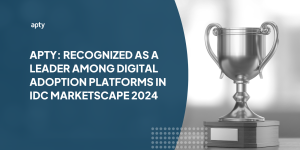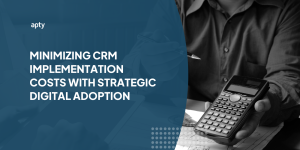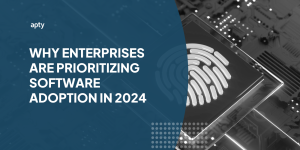In today’s banking sector, the adoption of digital banking has become a cornerstone for institutions seeking to thrive amidst the complexities of mergers and acquisitions (M&As). Navigating the complexities of mergers and acquisitions (M&As) in the banking sector demands a strategic focus on creating efficiencies, ensuring compliance, and facilitating seamless onboarding. These challenges, if not addressed adeptly, can significantly impact the success of an M&A, affecting everything from operational continuity to regulatory adherence and employee engagement.
Digital adoption platforms emerge as a crucial solution, providing the tools banks need to overcome these hurdles. They enable organizations to streamline operations by offering guided workflows and support, ensuring employees can quickly adapt to new systems and processes. This accelerates the onboarding of new software and minimizes the learning curve associated with these transitions.
As banks merge and acquire, adopting digital banking technologies becomes crucial in maintaining operational continuity, adhering to regulatory standards, and offering an enhanced customer experience.
What is digital banking?
Digital banking encompasses integrating digital technology into all banking operations, enhancing the customer experience, streamlining processes, and ensuring robust compliance practices. It signifies a move away from traditional brick-and-mortar services to a more dynamic, accessible, and efficient banking model.
The Adoption of Digital Banking
Consumer demand for more accessible and personalized banking services has accelerated the shift towards digital banking. This shift is crucial during M&As, as it ensures continuity in customer service. DAPs play a critical role here by enabling banks to quickly bring their digital services up to speed, ensuring that the newly merged entities can offer a cohesive, user-friendly digital banking experience.
The Impact of DAPs on M&As
Digital Adoption Platforms are transformational tools that enable banks to navigate the complexities of mergers and acquisitions with agility and precision. They ensure that banks can maintain operational efficiencies during these transitions, comply with regulatory demands, and offer seamless onboarding experiences. This, in turn, supports the broader adoption of digital banking, making it a critical element for success in today’s competitive market.
As banks continue to navigate the challenges and opportunities of mergers and acquisitions, the role of Digital Adoption Platforms becomes increasingly critical. DAPs are indispensable in enabling banks to achieve their strategic goals while providing superior service to their customers by fostering the adoption of digital banking, ensuring compliance, and enhancing operational efficiencies.
Let’s explore the significance of DAPs in operational streamlining in finance, software onboarding for banks, financial services digital transformation, compliance in banking technology, user adoption analytics in finance, and achieving cost savings in banking operations.
Creating Efficiencies and Seamless Onboarding
Efficiency in M&As is not just about reducing costs but optimizing operations to ensure smooth transitions and continuous service delivery. DAPs facilitate this by automating workflows and guiding users through new systems and processes.
This automation extends to onboarding – both for employees and customers – making it faster and more effective. As new systems and processes come online, DAPs provide the necessary support to ensure users can adapt without extensive downtime or training.
Ensuring Compliance
In the realm of banking, compliance is non-negotiable. Mergers and acquisitions introduce a plethora of regulatory considerations. DAPs shine in this area by embedding compliance into the digital onboarding and training processes, ensuring that all activities meet the stringent standards set by regulatory bodies.
This mitigates risk and instills stakeholders’ confidence that the bank maintains the highest integrity standards.
The significant impact of Digital Adoption Platforms (DAPs) in a leading global bank’s merger and acquisition scenario. The bank successfully navigated the integration of diverse software systems, achieving accelerated digital adoption and streamlining operational processes. This was made possible through strategic customization and seamless integration of the DAP, which facilitated quick adaptation to new systems for employees of all technical proficiencies.
The implementation led to notable outcomes, include:
- $1 Million in Savings: Achieved through strategic digital adoption during a critical M&A period.
- Analytics Visibility by 100%: Enhanced user interaction visibility, streamlined transitions, ensured data migration compliance.
- User Adoption at Scale: Successfully onboarded over 400,000 users, accelerating ramp up time and time to productivity.
- Software Integration Across 17+ Applications: Ensured a fast and unified user experience amidst complex and national M&A initiatives.
- Streamlined Operational Compliance: Apty’s validations feature fortified data integrity and regulatory compliance.
Digital transformation is reshaping industries at an unprecedented pace, with the BFSI (Banking, Financial Services, and Insurance), SaaS (Software as a Service), Pharma, and Retail sectors standing at the forefront of this evolution. Here’s how these industries are leveraging digital adoption to drive growth, enhance efficiency, and improve customer experiences, and achieve operational excellence:
BFSI Sector
The BFSI sector has experienced significant growth, with the global digital transformation market in this field valued at $68.2 billion in 2022 and projected to reach $310.7 billion by 2032, growing at a CAGR of 16.6% from 2023 to 2032. This growth is attributed to the pandemic-induced push towards digital channels, increased adoption of blockchain technology, and rising customer demand for online services.
Additionally, the IT BFSI market has expanded from $130.52 billion in 2022 to $149.50 billion in 2023. It is expected to reach $244.84 billion by 2027, driven by the penetration of digital payment methods and cutting-edge technologies.
Pharma Sector
The pharmaceutical industry’s digital transformation is equally impressive, with global spending on digital transformation expected to exceed $5 billion by 2023. Around 60% of pharma companies are introducing digital therapeutics and connected devices to improve patient-centered care. This surge is propelled by the adoption of digital therapeutics, connected devices to improve patient-centered care and the potential for a 10-15% increase in revenue through digital marketing efforts.
However, approximately 68% of the industry admits to not being fully prepared to integrate digital and physical channels, highlighting a significant area for growth and adaptation.
Retail Sector
The retail sector’s digital transformation market is expected to reach 868.71 billion and grow to $1.72 trillion by 2028 at a CAGR of 19.09% over the forecast period. Integrating IoT, cloud computing, big data, AI, and AR/VR technologies is enhancing operational efficiency in retail.
For instance, 71% of retailers are more interested than ever in IoT and 5G use cases to improve supply chain visibility and management. Adopting these technologies allows for personalized customer experiences, efficient inventory management, and enhanced customer engagement through AR and VR applications.
Cross-Industry Perspectives
Across these industries, digital transformation initiatives share common goals: improving operational efficiencies, enhancing customer engagement, and ensuring compliance with regulatory standards. Adopting AI, IoT, and cloud technologies is pivotal, with companies increasingly investing in digital strategies to remain competitive in a fast-evolving marketplace.
The journey towards digital adoption in these sectors underscores the critical role of technology in driving business growth and transforming traditional operational models. As industries continue to navigate the complexities of digital transformation, the focus on innovation, customer-centricity, and agile adaptation will be vital to achieving long-term success.
Understanding DAPs’ role across various sectors emphasizes their importance in the banking industry, particularly during mergers and acquisitions. They enable operational streamlining, enhancing compliance, and facilitating seamless onboarding.
DAPs support banking and sectors like BFSI, SaaS, Pharma, and Retail in their digital transformation journeys. These platforms ensure businesses can adapt to digital changes effectively, maintain regulatory compliance, and improve customer experiences, demonstrating their indispensable value in the digital economy.












